AUDI A3 2015 Owners Manual
Manufacturer: AUDI, Model Year: 2015, Model line: A3, Model: AUDI A3 2015Pages: 288, PDF Size: 71.46 MB
Page 261 of 288
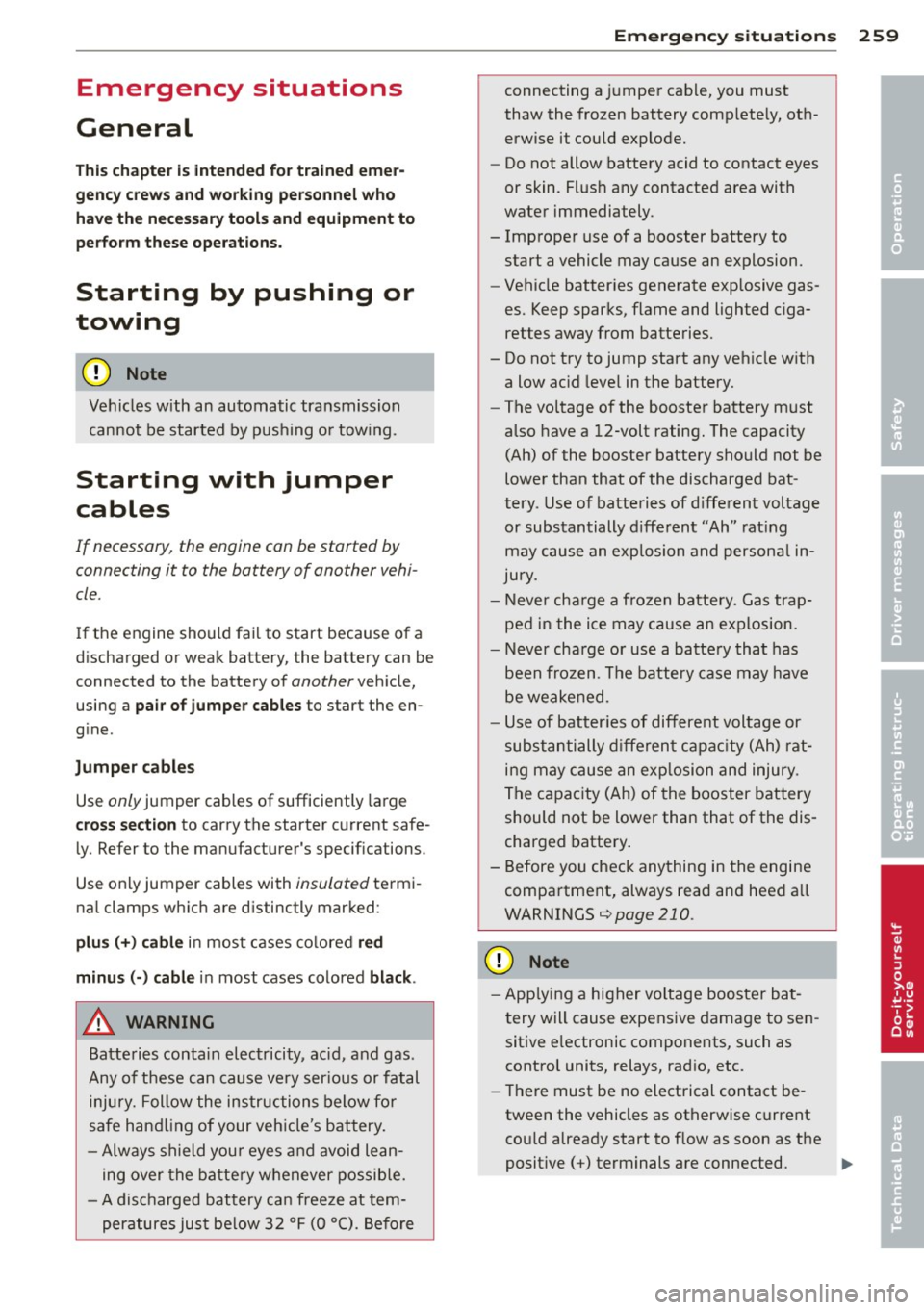
Emergency situations
General
This chapter is intended for trained emer
gency crews and working personnel who have the necessary tools and equipment to
perform these operations.
Starting by pushing or
towing
(D Note
Vehicles with an automatic transmission
cannot be started by pushing or towing.
Starting with jumper
cables
If necessary, the engine can be started by
connecting it to the battery of another vehi
cle.
If the engine should fail to start because of a
discharged or weak battery, the battery can be
connected to the battery of
another vehicle,
using a
pair of jumper cables to start the en
gine.
Jumper cables
Use only jumper cables of sufficiently large
cross section to carry the starter current safe
ly. Refer to the manufacturer's specifications.
Use only jumper cables with
insulated termi
nal clamps which are distinctly marked :
plus(+) cable in most cases colored red
minus(-) cable
in most cases colored black.
A WARNING
Batteries contain electricity, acid, and gas.
Any of these can cause very serious or fatal
injury. Follow the instructions below for
safe handling of your vehicle's battery.
- Always shield your eyes and avoid lean
ing over the battery whenever possible.
- A discharged battery can freeze at tem
peratures just below 32 °F (0 °C). Before
Emergency situations 259
connecting a jumper cable, you must
thaw the frozen battery completely, oth
erwise it could explode.
- Do not allow battery acid to contact eyes
or skin. Flush any contacted area with
water immediately .
- Improper use of a booster battery to start a vehicle may cause an explosion.
- Vehicle batteries generate explosive gas
es. Keep sparks, flame and lighted ciga
rettes away from batteries.
- Do not try to jump start any vehicle with a low acid level in the battery.
- The voltage of the booster battery must
also have a 12-volt rating. The capacity
(Ah) of the booster battery should not be
lower than that of the discharged bat
tery . Use of batteries of different voltage
or substantially different "Ah" rating
may cause an explosion and personal in
JU ry.
- Never charge a frozen battery. Gas trap
ped in the ice may cause an explosion.
-Never charge or use a battery that has
been frozen. The battery case may have
be weakened.
- Use of batteries of different voltage or
substantially different capacity (Ah) rat
ing may cause an explosion and injury.
The capacity (Ah) of the booster battery
should not be lower than that of the dis
charged battery.
- Before you check anything in the engine
compartment, always read and heed all
WARNINGS
¢ page 210.
(D Note
-Applying a higher voltage booster bat
tery will cause expensive damage to sen
sitive electronic components, such as
control units, relays, radio, etc.
- There must be no electrical contact be
tween the vehicles as otherwise current
could already start to flow as soon as the
positive(+) terminals are connected. ..,. •
•
•
Page 262 of 288
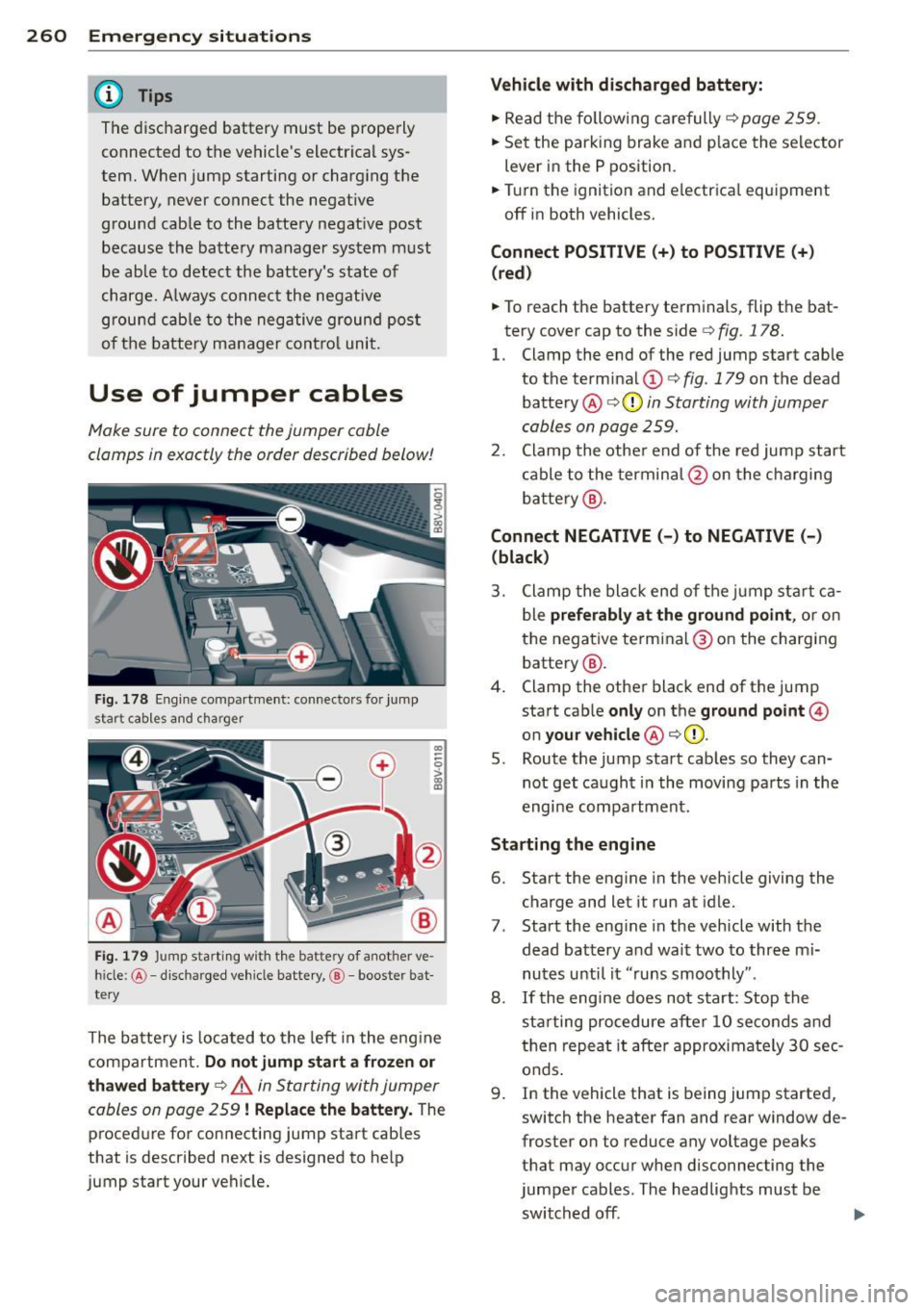
260 Emergency situations
@ Tips
The disc har ged battery must be properly
connected to the ve hicle's electrical sys
tem. W hen jump starting or charg ing t he
battery, never connect the negative
grou nd cab le to the batte ry negat ive post
because the batte ry ma nager sys tem must
be ab le to detect th e ba ttery 's state o f
charge. A lways connec t the nega tive
grou nd ca b le to t he neg ative ground pos t
of the batte ry ma nager con trol unit.
Use of jumper cables
Make sure to connect the jumper cable
clamps in exactly the order described below!
Fi g. 178 Eng ine compar tment: conne ctors for jump
start cables a nd charger
CD
--0 > ~
F ig. 1 79 Jump start ing with the battery of a nother ve·
h ide: @-di scharge d veh icle battery, @-booster bat
te ry
The ba tte ry i s loca ted to the left in the eng ine
compartment.
Do not jump start a frozen or
thawed battery
¢ .&. in Starting wi th jumper
cables on page 259
! Replace the battery. The
p roced ure fo r connecting jump start cab les
that is described next is designed to he lp
jump start your vehicle.
Vehicle with discharged battery:
.,. Read t he followi ng car efully¢ page 259.
.,. Se t the parking brake an d place the selector
lever in the P position.
.,. Tur n the ignition and electr ica l equ ipment
off in both vehicles.
Connect POSITIVE(+) to POSITIVE(+ )
(red )
.,. To reach the battery terminals, flip the bat
tery cover cap to the side¢
fig. 178.
1. Clamp the end of the red jump start cab le
to the term inal
(D ¢ fig. 179 on t he dead
batte ry @
¢ (Din Starting with jumper
cables on page 259.
2 . Clamp the othe r end of the re d jump start
c able to the termin al@ on the cha rging
b atte ry @ .
Connect NEGATIVE (-) to NEGATIVE(-)
(black)
3 . Clamp the bla ck end of the j ump st art ca
b le
preferably at the ground point , or on
the nega tive te rmi na l® on the chargi ng
battery @.
4. Clamp the othe r black end of the jump
start cab le
only on the ground point@
on your vehicle @¢(D.
S. Route the jump start cab les so they can
not get ca ught in the moving pa rts in the
engi ne compa rt m ent.
Starting the engine
6. Start the eng ine in the vehicle giving the
charge and let it run at idle.
7 . Start the eng ine in the vehicle with the
dead battery and wait two to three m i
nutes until it "runs smoothly" .
8.
If t he eng ine does not s tart: Stop the
sta rting procedure after 10 second s and
t h en re p eat it after approximately 3 0 sec
onds .
9 . In the vehicle that is being jump started,
switch the heater fan and rear window de
froster on to reduce any voltage peaks
that may occ ur whe n disconn ecting the
jumpe r cables. The headlights must be
switched off.
IJI,
Page 263 of 288
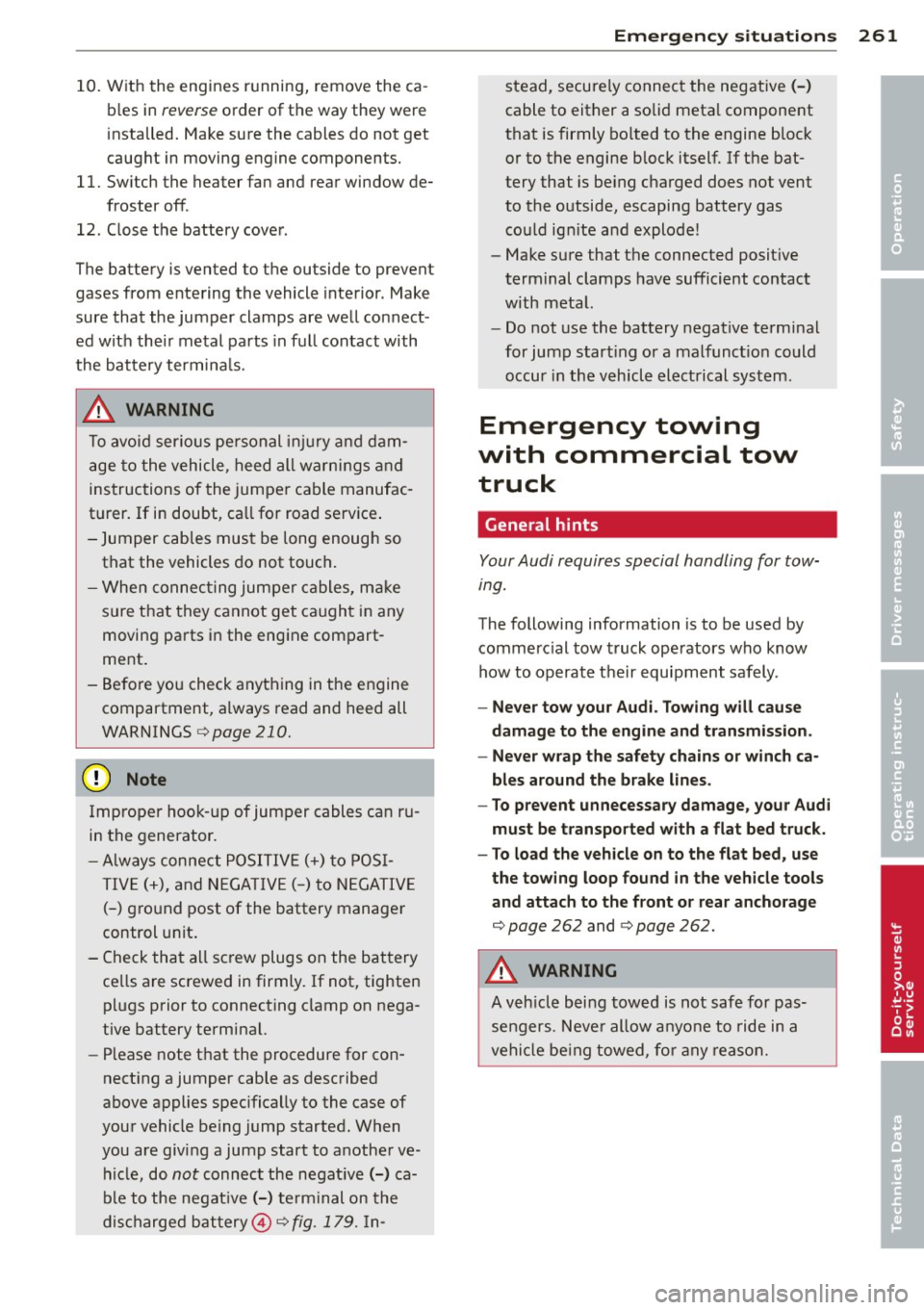
10. With the engines running, remove the ca
b les in
reverse order of the way they were
installed. Make sure the cables do not get
caught in moving engine components.
11. Switch the heater fan and rear window de-
froster off .
12 . C lose the battery cover.
The battery is vented to the outside to prevent
gases from entering the vehicle interior . Make
sure that the jumper clamps are well connect
ed with their metal parts in full contact with
the battery termina ls.
.&, WARNING
To avoid serious pe rsonal injury and dam
age to the vehicle, heed all warnings and
instructions of the jumper cable manufac
turer. If in doubt, ca ll for road service .
- Jumper cables must be long enough so
that the vehicles do not touch.
- When connecting jumper cables, make
surethattheycannotgetcaughtinany
moving parts in the engine compart
ment.
- Be fore you check anything in the engine
compartment, always read and heed all
WARNINGS
~ page 210.
(D Note
Improper hook-up of jumper cables can ru
in the generator.
- Always connect POSITIVE( +) to POSI
TIV E(+), and NEGA TIVE( -) to NEGATIVE
( - ) ground post of the battery manager
control un it .
- Check that all screw plugs on the battery
ce lls are screwed in firmly. If not, tighten
plugs prior to connecting clamp on nega
tive battery terminal.
- Please note th at the procedure for con
necting a jumper cable as described
above applies specifically to the case of
your vehicle be ing jump started. When
you are giv ing a jump start to another ve
hicle, do
not connect the negat ive( -) ca
ble to the negat ive( -) term inal on the
discharged battery@~
fig. 179. In-
-
Em erg en cy si tuation s 261
stead, secure ly connect the negative( -)
cable to either a solid meta l component
that is firmly bo lted to the engine block
or to the engine block itself. If the bat
tery that is be ing charged does not vent
to the outside, escaping battery gas could ig nite and explode!
- Make sure that the connected positive
terminal clamps have sufficient contact
with metal.
- Do not use the battery negat ive terminal
for jump start ing or a malfunct ion could
occur in the vehicle electrical system .
Emergency towing
with commercial tow
truck
General hints
Your Audi requires special handling for tow
ing.
The following information is to be used by
comme rc ial tow truck operators who know
how to operate their equipment safely.
-Ne ver t ow your A udi. Towing will caus e
da mage to the engin e and tr an smi ssion .
- Nev er wrap the safet y chains or wi nch ca
ble s around the brak e lines.
- To p revent unnecessar y damage , your Aud i
must be t ran spor ted with a flat bed truck.
- To lo ad the vehicle on to the fl at bed , u se
the to w ing loop found in the vehicle tool s
and attach to the front or rear ancho rage
~ page 262 and ~page 262.
.&, WARNING
A veh icle being towed is not safe for pas
sengers. Neve r allow a nyone to ride in a
vehi cle be ing towed, fo r any reason.
-
•
•
•
Page 264 of 288
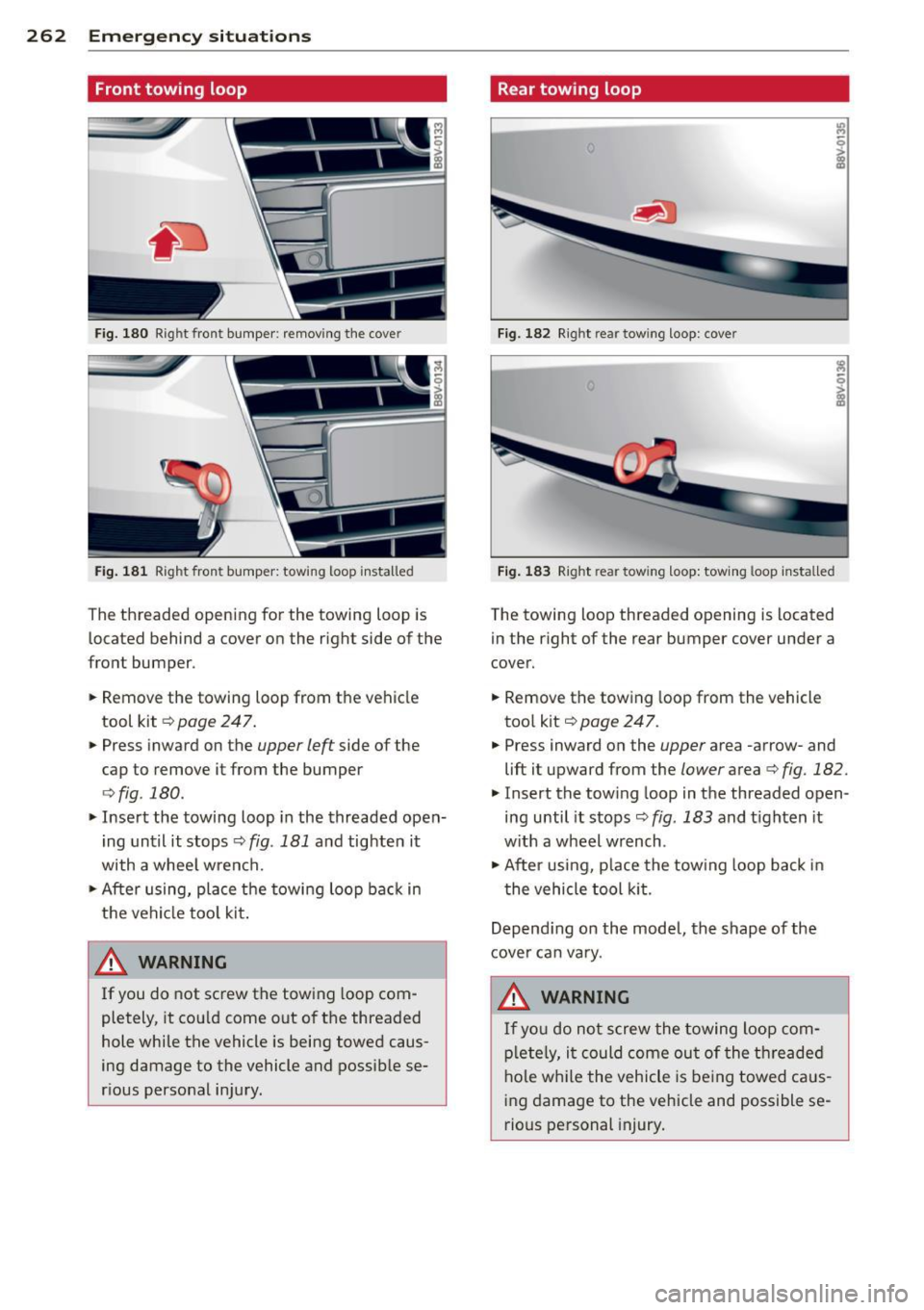
262 Emergency situations
Front towing loop
Fig. 180 Right front bumper: removing the cove r
Fig. 181 Right front bumper: towing loop installed
The threaded opening for the towing loop is
located behind a cover on the right side of the
front bumper.
• Remov e the towing loop from the vehicle
tool kit¢
page 247.
• Press inward on the upper le~ side of the
cap to remove it from the bumper
¢fig . 180.
• Insert the towing loop in the threaded open
ing until it stops¢
fig. 181 and tighten it
with a whee l wrench.
• After using, place the towing loop back in
the vehicle tool kit.
A WARNING
If you do not screw the towing loop com
pletely, it cou ld come out of the threaded
hole while the vehicle is being towed caus
ing damage to the vehicle and possible se
r ious personal injury.
-
Rear towing loop
Fig. 182 Righ t rea r towing loop: cover
Fig. 183 Right rea r towing loop: towing loop installed
The towing loop threaded opening is located
in the right of the rear bumper cover under a
cover.
• Remove the towing loop from the vehicle
tool kit ¢
page 247.
• Press inward on the upper area -arrow-and
lift it upward from the
lower area¢ fig. 182.
• Insert the towing loop in the threaded open
ing until it stops ¢
fig. 183 and tighten it
w ith a wheel wrench .
• After using, p lace the towing loop back in
the vehicle tool kit.
Depending on the model, the shape of the
cover can vary.
.&_ WARNING
If you do not screw the towing loop com
pletely, it could come ou t of the threaded
hole while the vehicle is being towed caus
ing damage to the vehicle and possible se
rious personal injury.
-
Page 265 of 288
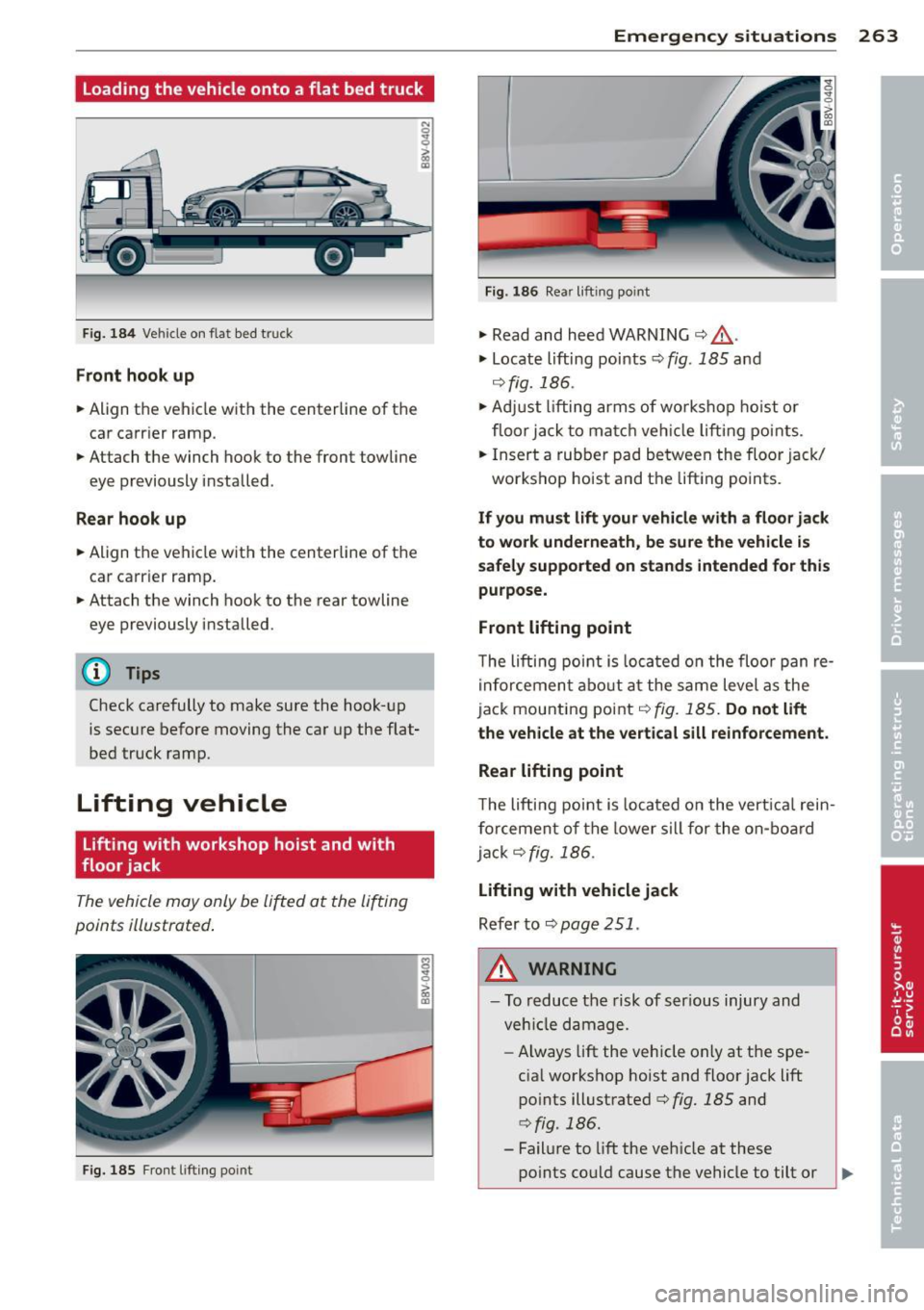
Loading the vehicle onto a flat bed truck
Fig. 184 Ve hicle on fla t bed t ruck
Front hook up
.. Align the vehicle with the centerline of the
car carr ier ramp.
.. Attach the winch hook to the front towline
eye previously installed .
Rear hook up
.. Align the vehicle w ith the centerline of the
car carrier ramp.
.. Attach the winch hook to the rear towline
eye previously installed.
(D} Tips
Check carefully to make sure the hook- up
is secure before moving the car up the flat
bed truck ramp .
Lifting vehicle
Lifting with workshop hoist and with
floor jack
The vehicle may only be lifted at the lifting
points illustrated .
Fig. 185 Fro nt l ifting po int
N 0
~ >
"' m
Emergenc y situ ation s 263
Fig. 1 86 Rea r liftin g po int
.,. Read and heed WARNING c::> .&, .
.,. Locate lifting points c::> fig. 185 and
¢ fig. 186 .
.,. Adju st lifting arms of wo rkshop ho ist or
floor jack to ma tch veh icle lifting points.
.. Insert a rubbe r pad be tween the floor jack/
workshop hoist and the lift ing points.
If y ou mu st lift your veh icle with a fl oor jack
to w ork und erneath , be sure the vehicle is
safel y supported on stand s intended for thi s
purpo se .
Front lifting point
T he lifti ng point is loca ted o n the floo r pan re
i nforcemen t abo ut a t the same level as the
jack mounting point
c::> fig. 185. Do not lift
the vehicle at the vertic al sill reinforcement.
Rear lifting point
T he lifting point is located o n the vert ica l rein
f o rcement of the lower s ill for the on-board
jack
c::> fig. 186 .
Lifting with vehicle jack
Refer to ¢page 251.
A WARNING
-To reduce the risk of ser ious injury and
veh icle damage.
- Always lift the vehicle only at the spe
cia l workshop hoist and floor jack lift
points illustrated
c:;, fig. 185 and
¢ fig. 186.
- Fail ure to lift the veh icle at these
-
po ints could cause the vehicle to tilt or ..,.
Page 266 of 288
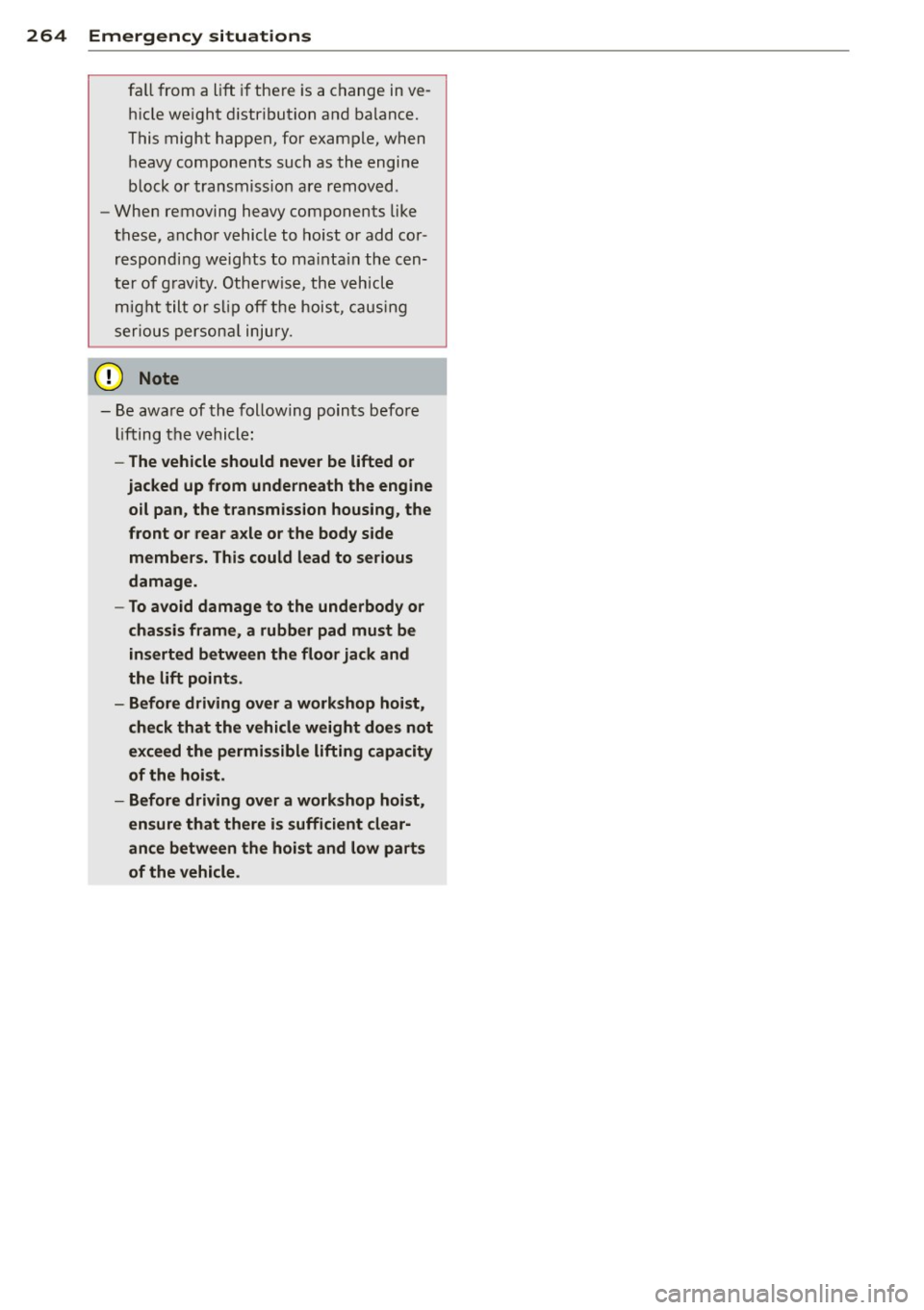
264 Emergency situations
fall from a lift if there is a change in ve
hicle weight distribution and balance.
This might happen, for example, when
heavy components such as the engine
block or transmission are removed .
- When removing heavy components like
these, anchor vehicle to hoist or add cor
responding weights to maintain the cen
ter of gravity. Otherwise, the vehicle
might tilt or slip off the hoist, causing
serious personal injury.
(D Note
- Be aware of the following points before
lifting the vehicle:
-The vehicle should never be lifted or
jacked up from underneath the engine
oil pan, the transmission housing, the
front or rear axle or the body side
members. This could lead to serious
damage.
- To avoid damage to the underbody or
chassis frame, a rubber pad must be
inserted between the floor jack and
the lift points.
- Before driving over a workshop hoist,
check that the vehicle weight does not
exceed the permissible lifting capacity
of the hoist.
- Before driving over a workshop hoist,
ensure that there is sufficient clear
ance between the hoist and low parts
of the vehicle.
Page 267 of 288
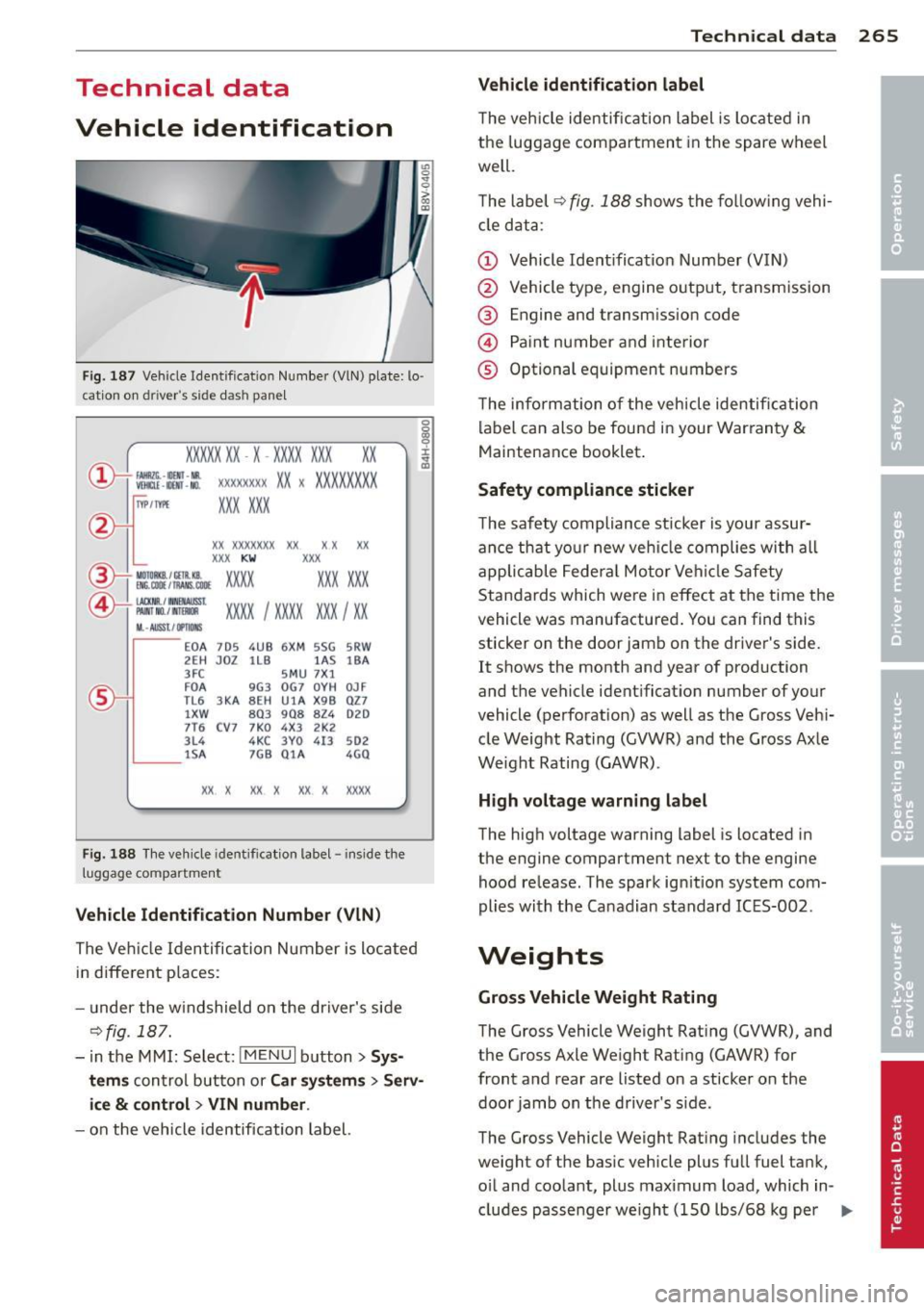
Technical data
Vehicle identification
F ig. 187 Veh icle Identificat ion Number (VlN) plate: lo·
cat ion on driver's side dash pane l
XXXXX XX · X -XXXX XXX
~ fAllftlli. -llllll · NR. ~ W!ru -llllll -NO.
xx
XXXX XXXX XX X XXXXXXXX
XXX XXX
IYP /TYPE
XX XXXX XXX XX X X XX
XXX
KW XXX
®i ~W.::·f :l~~ XXXX XXX XXX
©+ ::rw= xxxx I xxxx XXX I xx
M. · AUSSt I IJ'IIDIIS
EOA 7D5 4UB 6XM SSG SR W
2EH JOZ 1LB lAS
18A
3FC SMU 7Xl
FDA 9G3 OG7 OYH
OJF
TL6 3KA 8EH
UlA X98 027
l XW 803 908 824 D2D
7T6 CV7 7KO 4X3 2K2
3L4 4KC 3YO 413 502
1SA 7GB 01A 4GO
XX . X XX X XX X XXXX
Fig. 188 The vehicle identification label- in side the
l uggag e compartme nt
Vehicle Identification Number (VlN)
The Veh icle Identifica tion Number is located
in different p laces :
- under the w indshield on the driver's side
¢fig. 187.
- in the MMI: Select: !MENUI button> Sys
tems
control button or Car systems > Serv
i ce
& co ntrol > VIN number .
-on the vehicle identification label.
Technical data 265
Vehicle identification label
The vehicle identification label is located in
the luggage compartment in the spare wheel
well.
T he label¢
fig. 188 shows the following vehi
cle data:
(D Vehicle Identification Number (VIN)
@ Vehicle type, engine output, transmission
® Engine and transmission code
© Paint number and interior
® Optional equipment numbers
The information of the veh icle identification
label can also be found in your Warranty
&
Maintenance booklet .
Safety compliance sticker
The safety compliance sticker is your assur
ance that your new vehicle complies with all
applicable Federal Motor Vehicle Safety
Standards which were in effect at the time the
vehicle was manufactured . You can find this
sticker on the door jamb on the driver's side.
It shows the month and year of production
and the vehicle ident ification number of your
vehicle (perforation) as well as the Gross Vehi
cle Weight Rating (GVWR) and the Gross Axle
Weight Rating (GAWR) .
High voltage warning label
The high voltage warning label is located in
the engine compartment next to the engine
hood release. The spark ignition system com
plies with the Canadian standard ICES-002 .
Weights
Gross Vehicle Weight Rating
The Gross Vehicle Weight Rating (GVWR), and
the Gross Axle Weight Rating (GAWR) for
front and rear are listed on a sticker on the
door jamb on the driver's side.
The Gross Vehicle Weight Rating includes the
weight of the basic vehicle plus full fuel tank,
o il and coolant, plus maximum load, which in
cludes passenger we ight (150 lbs/68 kg per
II>--
Page 268 of 288

26 6 Techni cal data
designated s eating position) and luggage
w eight ¢.&, .
Gross Axle W eight Rating
The Gross Axle Weight Rating is the maximum
l oad that can be applied at each axle of the
vehicle ¢Lr!, .
Vehicle cap acit y weight
The vehicle capac ity we ight (max . load) is list
ed either on the dr iver's side B-pilla r or inside
the fuel filler flap.
_& WARNING
- T he actual Gross Axle Weight Rat ing at
the front and rear axles shou ld not ex
ceed the permissible weights, and their
combination must not exceed the Gross
Vehicle Weight Rating .
Dimensions
The dimensions can vary depend ing on the
model and equipment.
Length
Width
W idth (ac ross m irrors)
Height (unloaded) a)
Turn ing circle d iameter
-
- Exceeding permissible weight ratings can
result in veh icle damage, acc idents and
personal injury.
(D Note
- The vehicle capacity weight figures apply
when the load is distributed evenly in the
vehicle (passengers and luggage). When
transport ing a heavy load in the luggage
compartment, carry the load as near to
the rear axle as poss ible so that the vehi
cle's handling is not impaired .
- Do not exceed the maximum permissible axle loads or the maximum gross veh icle
we ight. Always remember that the vehi
cle's handling w il l be affected by the ex
tra load. Therefo re, adj ust your speed ac
cordingly.
- Always observe local regulat ions .
in (mm)
175 .3 (4456)
in (mm) 70 .7 (1796)
in (mm) 77 .l (1960)
in (mm) 55 .7 (1416)
ft (m) 35.8 (10.9)
al The he igh t o f th e ve hicle depe nds o n the tire s and the s usp en sion .
When driving on poor roads, by curb s and on
s teep ramp s, make sure tha t low-lying compo
nent s such as the spoiler and exhaust sy stem
Capacities
Fuel tank
Front whee l Drive
All wheel drive
Winds hield washer system do not
come into contact w ith these or they
could be dam aged. This applies espe cia lly
when the vehicle is fully loaded .
gal (liters) approx.
13.2 (50.0)
gal (lite rs) approx. 14.5 (55.0)
quarts (liters) approx. 3.2 (3.1)
Page 269 of 288
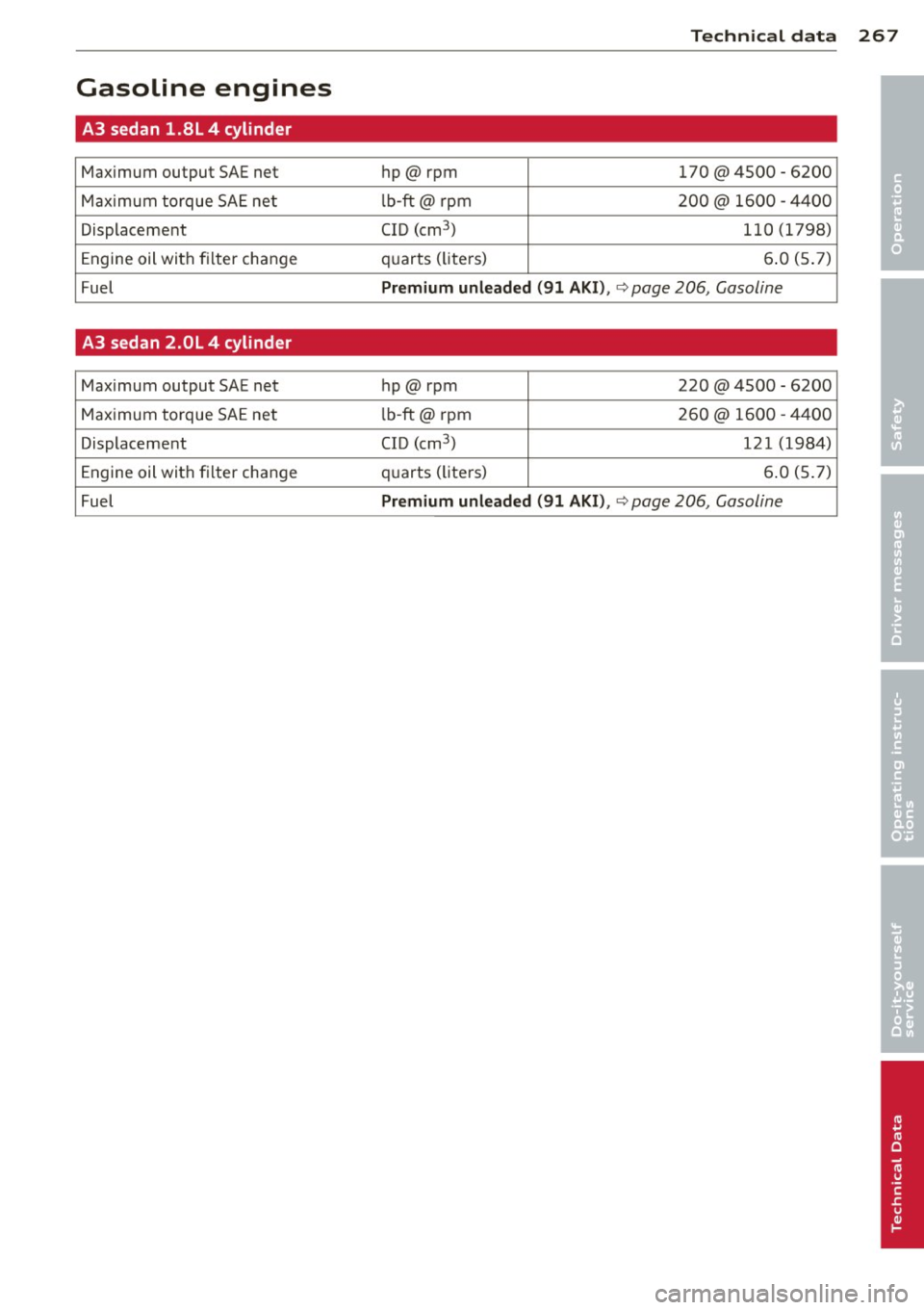
Gasoline engines
A3 sedan l.8L 4 cylinder
Maximum output SAE net
Maximum torque SAE net
Displacement
Engine oil with filter change
Fuel
A3 sedan 2.0L 4 cylinder
Maximum output SAE net
Maximum torque SAE net
Displacement
Engine oil with filter change
Fuel
Techn ical data 267
hp@rpm 170 @ 4500 - 6200
l b-ft@ rpm 200@ 1600 - 4400
CID (cm
3 ) 110(1798)
quarts (liters) 6.0(5.7)
Premium unleaded (91 AKI), ¢ page 206, Gasoline
hp@rpm 220 @ 4500 - 6200
l b-ft@ rpm 260@ 1600 - 4400
CID (cm
3 ) 121 (1984)
quarts (liters) 6.0(5.7)
Premium unleaded (91 AKI) , ¢ page 206, Gasoline
•
•
Page 270 of 288
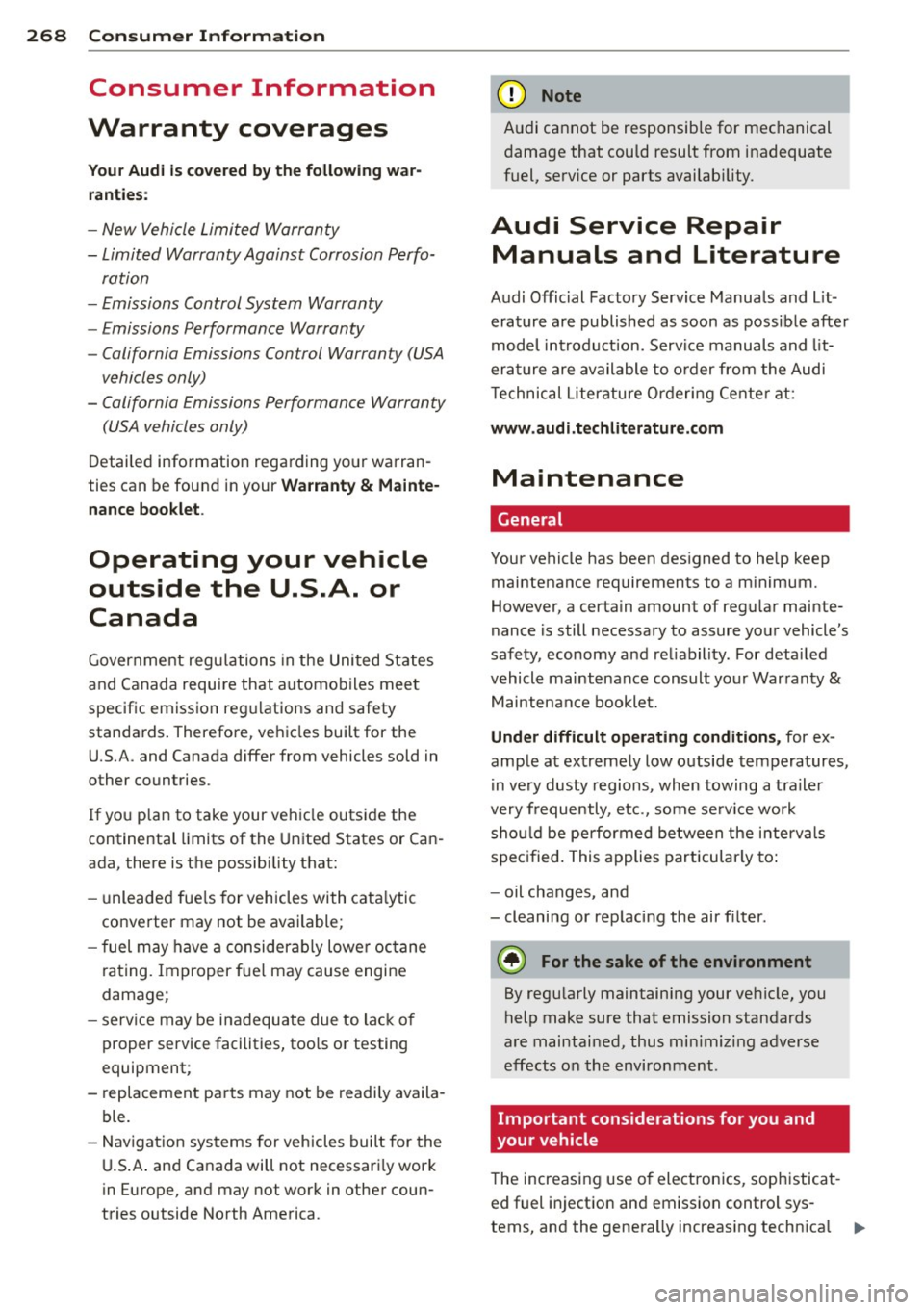
268 Consumer Information
Consumer Information
Warranty coverages
You r Audi is covered by the following war
ranties:
- New Vehicle Limited Warranty
- Limited Warranty Against Corrosion Perfo-
ration
- Emissions Control System Warranty
- Emissions Performance Warranty
- California Emissions Control Warranty (USA
vehicles only)
- California Emissions Performance Warranty
(USA vehicles only)
Detailed information regarding your warran
ties can be found in your
Warranty & Mainte
nance booklet .
Operating your vehicle
outside the U.S.A. or
Canada
Government regu lations in the United States
and Canada require that automobiles meet
specific emission regulations and safety
standards. Therefore, veh icles built for the
U.S.A . and Canada differ from vehicles sold in
other countries .
If you p lan to take your vehicle outside the
continental limits of the United States or Can
ada, there is the possibility that:
- unleaded fuels for vehicles with cata lytic
converter may not be available;
- fuel may have a considerably lowe r octane
rating. Improper fuel may cause engine
damage ;
- service may be inadequate due to lack of
proper service facilities, tools or testing
equipment ;
- replacement pa rts may not be readily availa
ble.
- Navigation systems for vehicles built for the
U.S.A. and Canada will not necessar ily work
in Europe, and may not work in other coun
tries outside North America .
(D Note
Audi cannot be responsible for mechanical
damage that could result from inadequate
fuel, service or parts availability.
Audi Service Repair Manuals and Literature
Audi Official Factory Service Manuals and Lit
erature are published as soon as possible after
model introduction. Service manuals and lit
erature are available to order from the Audi
T echnical Literature Ordering Center at:
www.audi.techliterature.com
Maintenance
General
Your vehicle has been designed to help keep
maintenance requirements to a minimum.
However, a certain amount of regular mainte
nance is still necessary to assure your vehicle's
s afety, economy and rel iability. For detailed
vehicle maintenance consult your Warranty &
Maintenance booklet.
Under difficult operating conditions, for ex
ample at extremely low outside temperatures,
i n very dusty regions , when towing a trailer
very frequently, etc., some service work
should be performed between the intervals
specified. This applies particularly to:
- oil changes, and
- cleaning or replacing the air filter .
(® For the sake of the environment
By regularly maintaining your vehicle, you
help make sure that emission standards
are maintained, thus minimizing adverse
effects on the environment.
Important considerations for you and
your vehicle
The increasing use of electronics, sophisticat
ed fuel injection and emission contro l sys-
tems, and the genera lly increasing technical
liJJ,